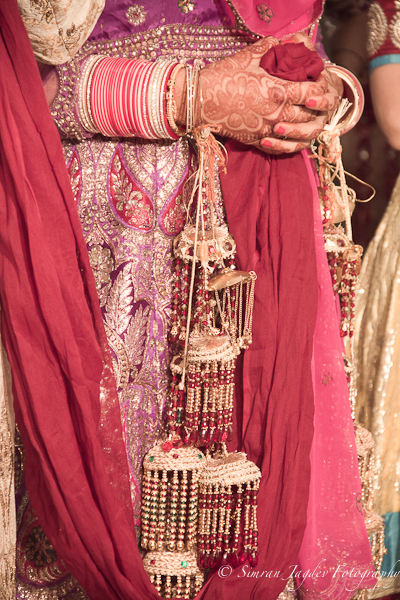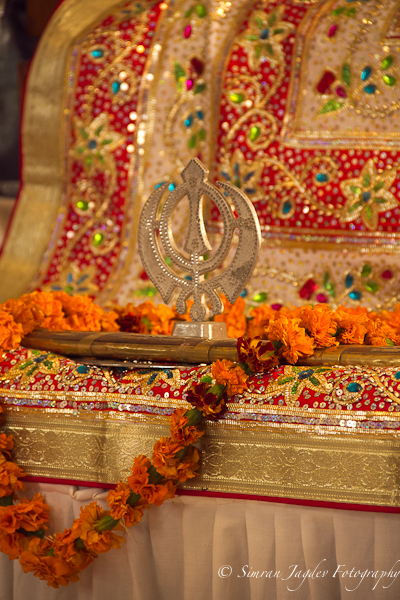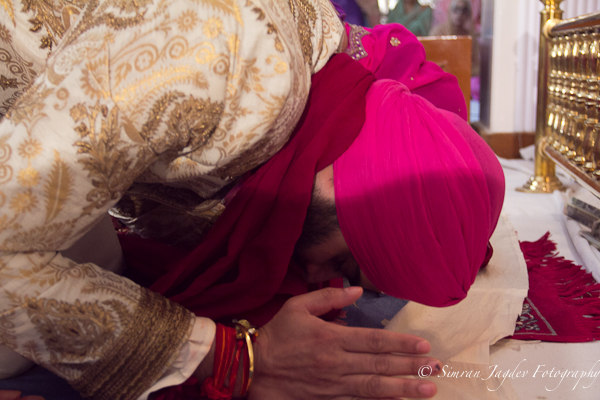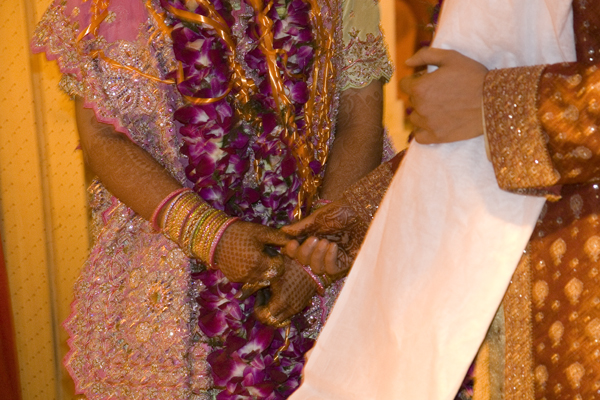The Sikh Wedding Ceremony
This week we will be focusing on Sikh Weddings. Sikh Weddings are full of lovely traditions, symbolism, culture, and beautiful values. Our series continues with the Day-of festivities.
On the day of the wedding, the bride and the groom are prepared for the ceremony by the members of their family.
Preparation

At the bride’s home, ornaments made of silver and gold resembling a shape of an umbrella, known as Kalira, are tied to her bangles or chooda by her family members. Kalira symbolizes warm wishes and blessings, and the bride wears them until the wedding ceremony is concluded. Once the kalrias are tied, the bride shakes them on the heads of unmarried friends and girls of the family. According to an old adage, if part of a kalira falls on one of the girl’s, she is next in line to be married.
At the groom’s home, the groom’s sister-in-law and female relatives, go to a nearby well or Gurdwara to fill an earthen pitcher with water, which is later used to bathe the groom. This ceremony is named after the earthen pitcher, known as Gharoli.
Groom’s Procession
This is followed by tying of Sehara or a veil made of flowers to the groom’s forehead. The groom’s sisters partake in Sehara Bandhi and also adorning him with a garland made of currency notes. At this point, the groom’s procession or Baraat heads towards to the wedding venue for Anand Karaj.
Literally meaning a blissful union, Anand Karaj, is the name of a traditional Sikh ceremony taking place at a Gurdwara or a Sikh temple, typically in the morning.
The Baraat is received by the bride’s family, and the two families greet each other, also known as Milni. The traditional Sikh greeting is “Wahe Guru Ji Ka Khalsa, Wahe Guru Ji Ki Fateh”, which means victory belongs to Wahe Guru or Wondrerous Giver of Knowledge. During this ceremony, holy Shabads or hymns from the Sikh Scripture, Guru Granth Sahib, are sung. An Ardaas or prayer may also be said at the Milni.
Anand Karaj

The Sikh Wedding Ceremony takes place in the holy presence of Guru Granth Sahib in the presence of wedding parties and guests. Shabads are sung and the bride and the groom sit next to each other facing Guru Granth Sahib. The bride sits on the left side of the groom. The couple and their parents (or guardians) stand up for the offering of prayers, seeking the blessings of Wahe Guru for the commencement of the Anand Karaj.
Any Amritdhari Sikh, a man or woman who has gone through traditional Amrit Initiation and practices the prescribed Sikh code in daily life, can perform the Anand Karaj ceremony. This officiating person apprises the couple of the duties of married life according to the Guru’s teachings. He or She explains their mutual obligations as husband and wife. Sikh husband-wife love is based on the love between human soul and the Supreme Soul as described in the Four Lavan. These are hymns composed by the Fourth Guru in the Suhi Raag section of Guru Granth Sahib and represent four stages of love. The groom and the bride vow fidelity to each other in the presence of the Guru Granth Sahib and the holy congregation. They accept their obligations by bowing before Guru Granth Sahib.

In the main ceremony, the groom wears a sash over his shoulder, where the end of the sash is placed by the bride’s father in the hands of the bride. The officiant reads the four lavan. After the reading of the first lavan, the couple rises and to the accompaniment of hymns sung by ragis or musicians, walk slowly round Guru Granth Sahib, the groom leading the bride. After returning to their position in front of Guru Granth Sahib, the couple remains standing while the next lavan is read. This is repeated until the fourth lavan and round around the Guru Granth Sahib is finished.
After the fourth lavan, the hymn of Anand Sahib is read by the ragis. There is an Ardaas of completion of the ceremony. Holy Vaak or random reading of a hymn from the holy scripture is read out and the holy sweet pudding or Karah Pasad is distributed to all present. This is followed by a grand feast.

Post Wedding
A traditional Sikh wedding consists of Vidaii or Doli. In this ceremony, the bride bids farewell to her family members and hence, is an emotional occasion. As the bride departs, she throws back handful of rice over her shoulder. Girls are considered as incarnation of Lakshmi, who is the Goddess of wealth and prosperity. As the girl or Lakshmi leaves the maternal home to begin a new life, by throwing rice over her shoulder, she wishes prosperity for her parents and family.
Tomorrow we will be featuring a story of a lovely couple followed by their Sikh Wedding Ceremony next week! Stay tuned for some beautiful pictures.
Image Credit
Photography by Simran Jagdev
Simran Jagdev is a Photographer based out of Delhi. Simran specializes in Weddings, Engagement/Pre-Wedding and Lifestyle Shoots.
 Agarwal Wedding Ceremony
Agarwal Wedding Ceremony Featured UK Wedding: Nikki + Amish
Featured UK Wedding: Nikki + Amish
Shana says
Great article. Just a note: you do not have to be Amritdhari Sikh to perform the Anand Karaj. Anyone can perform it, as long as they can read the scripture. It might be a good idea to update and change that part of your article.
neha says
Thanks Shana! I really appreciate you pointing that out. I will definitely update the article.